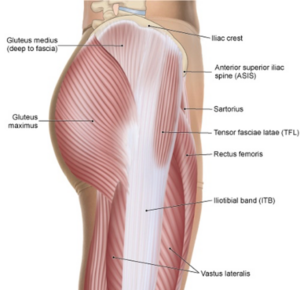A Balanced Approach to Lateral Hip Pain

In this week’s Clinical Insight we reflect back on a couple of conversations regarding the management of lateral hip pain.
We recently ran a CPD session that looked at interventions around tendinopathy, and persistent joint pain, and certainly lateral hip pain is a common condition that we come across often.

Lateral hip pain, or GTPS, as we know is very difficult to be clinically specific about, and even with the use of imaging it remains a tough call to understand the exact pathogenesis of the condition. We know that there are greater ratios of female to male presenting with the condition (4:1), with the likely demographic from 40 to 60 years old.
A history of certain medication uses or metabolic diseases (e.g. diabetes, hypercholesterolaemia) can also be risk factors, as well as ongoing inflammatory sensitivity due to fat releasing mediators that can potentially lead to ongoing painful experiences in obesity.
Clinical tests such as single leg stance for 30 seconds, and inability to perform resisted external de-rotation in supine at 90-degree hip flexion are cited. Localised tenderness adds to the cluster as well as importantly ruling out any other potential contributors to the presentation, such as intra articular pathology and/or low back somatic or radicular referral patterns (Sunil Kumar et al 2021).
What is also then seen and looked for are contributing factors leading to an ongoing pain state. These will be physical, such as biomechanical, which may be seen as weakness, loss of effective balance control, lacking load tolerance and emotional factors that long-term pain can lead to.
Therefore, this is a whole system problem.
Treatment Options
Exercise to improve the load tolerance of the abductor complex with all the key principles of load capacity assessment, variability, balance, speed, etc needs to be employed to suit the end point tasks that are set as shared goals.
Injections, as we know, can help with short-term pain relief and offer value if pain limits capacity to exercise, but should be considered carefully due to risks (Grimaldi 2017). Shock Wave again holds short term gains, but does not offer the long-term benefit of a progressive exercise approach.
Therefore, our reflection centred around the need to look at adaptive structures such as the tendon, providing greater tensile strength and increasing ability to mange a variable load through repetitive movements.
Offering a better biomechanical load across the tendon, and that may be through advice, education, lifestyle modification or some external support such as orthotics. The need for weight loss not because of weight/load but for potentially reducing peripheral sensitisation should be considered. The need to see how the medical management of any metabolic disorder is functioning, which needs the appropriate review, and good weight loss management are all integral to the overall picture.
Lastly, we know patients with hip pathology can display psychological comorbidities that can be improved with a rounded care model (Gudmundsson et al 2021).
In conclusion, the team supported the management of this condition needing a multi-factorial approach with structured, comprehensive and supportive rehabilitation principles. A sheet of exercises will not do the job.
References
Grimaldi, A., 2017. Conservative management of lateral hip pain: the future holds promise. British Journal of Sports Medicine, 51(2), pp.72-73.
Gudmundsson, P., Nakonezny, P.A., Lin, J., Owhonda, R., Richard, H. and Wells, J., 2021. Functional improvement in hip pathology is related to improvement in anxiety, depression, and pain catastrophizing: an intricate link between physical and mental well-being. BMC musculoskeletal disorders, 22, pp.1-9.
Sunil Kumar, K.H., Rawal, J., Nakano, N., Sarmento, A. and Khanduja, V., 2021. Pathogenesis and contemporary diagnoses for lateral hip pain: a scoping review. Knee Surgery, Sports Traumatology, Arthroscopy, 29, pp.2408-2416.